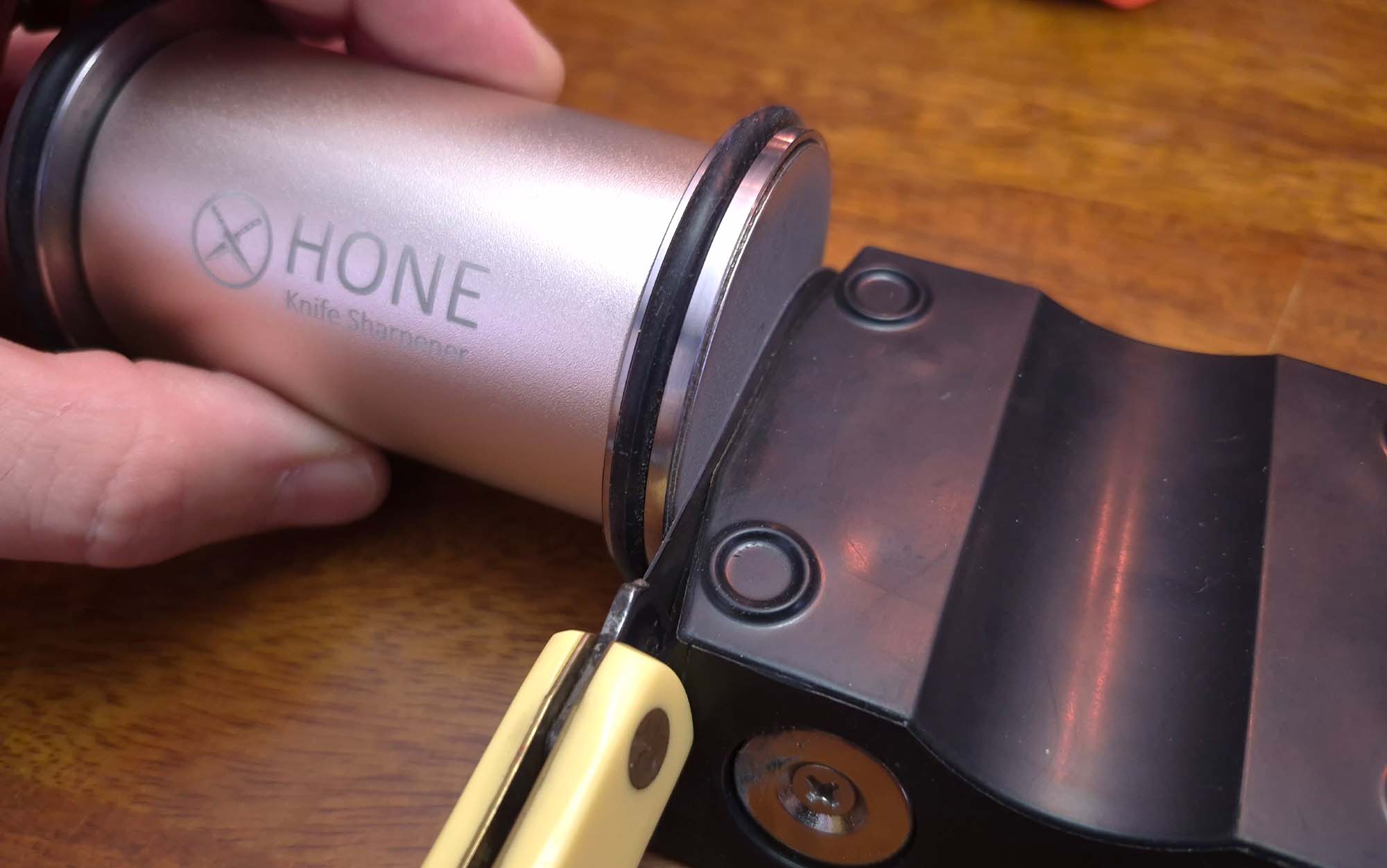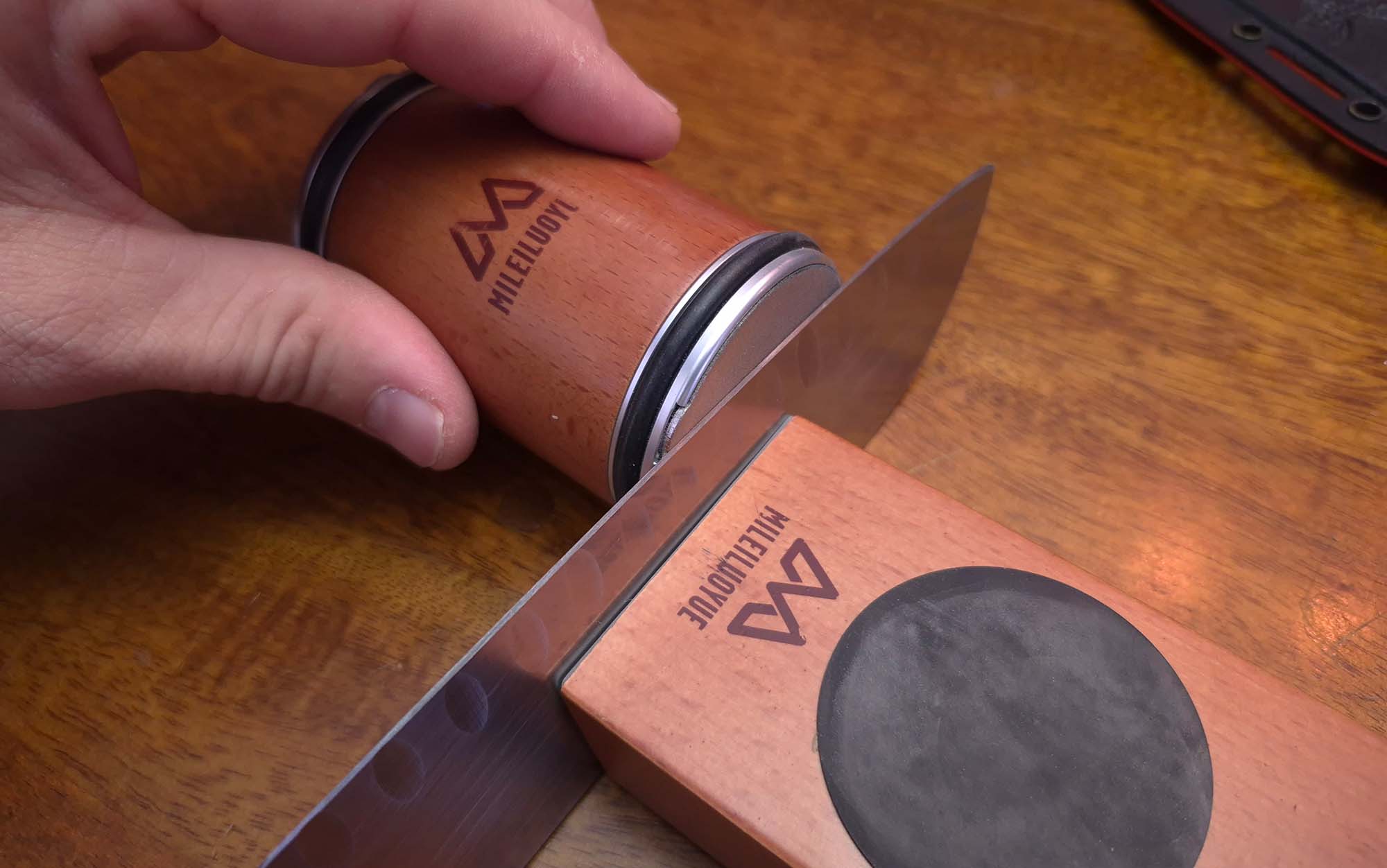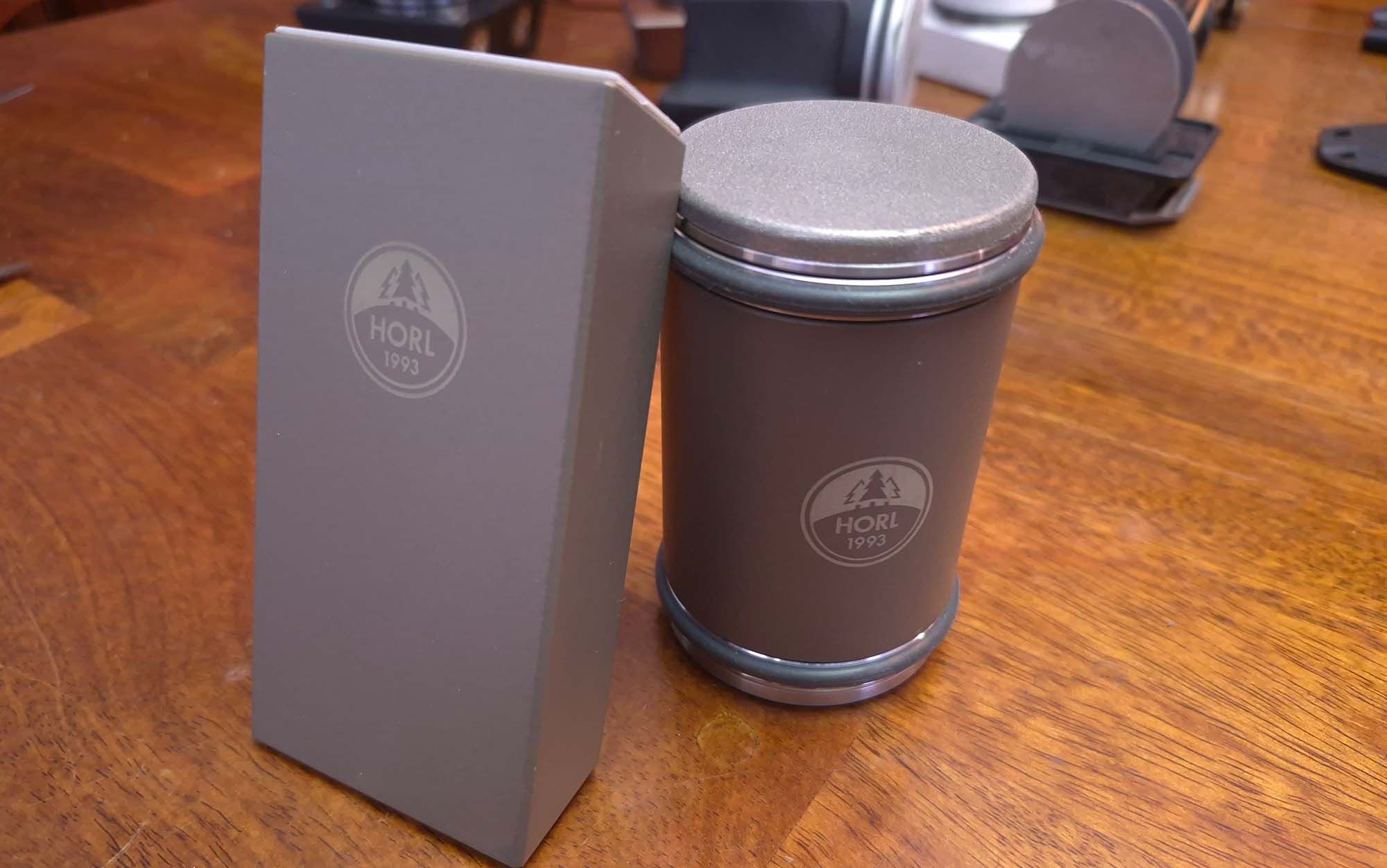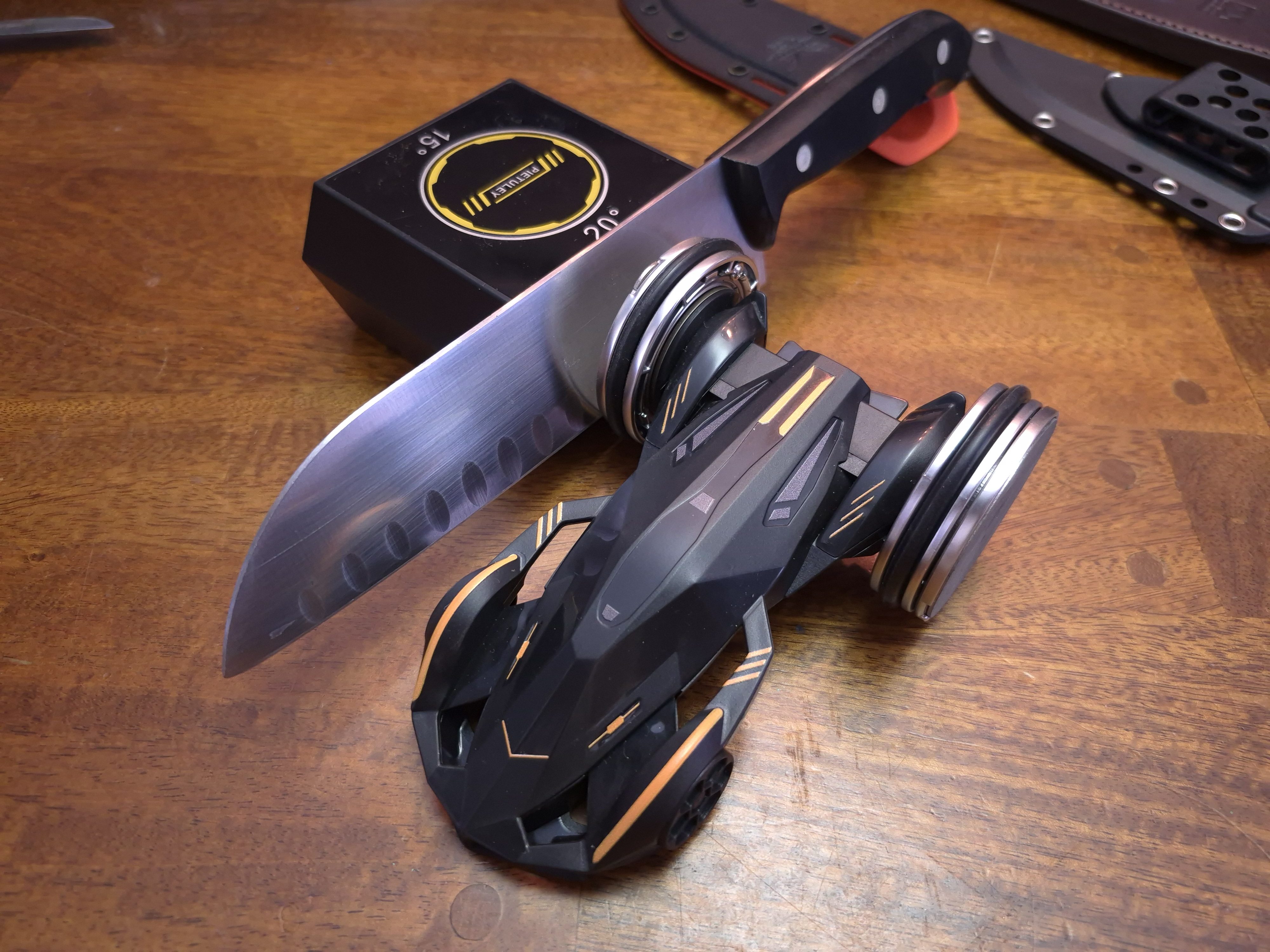The Best Rolling Knife Sharpeners of 2025, Tested and Reviewed
We may earn revenue from the products available on this page and participate in affiliate programs. Learn More ›
Rolling knife sharpeners have gained a lot of popularity in the last several years because they make sharpening incredibly easy. There are plenty of companies producing their own take on these user-friendly sharpener. But, with all the choices, which one works best? Do they actually get knives that sharp?
I put seven rolling knife sharpeners to the test by sharpening a wide variety of blades. That hands-on testing helped me figure out what worked, and what didn’t. The sharpeners ranged in price from $25 all the way up to $339 and had a surprising variety of design differences. The winner of the test was the Work Sharp Rolling Knife Sharpener, which continues Work Sharp’s domination in the world of knife sharpening. If you’re looking for a rolling sharpener that can put an edge on just about any knife, the HONE is my recommendation. If you want to spend around $25 on a capable sharpener, the Mileiluoyue is the one to buy. Here is the full list of the sharpeners I tested and in-depth reviews on each:
- Best Overall: Work Sharp Rolling Knife Sharpener
- Most Versatile: HONE
- Best Budget: Mileiluoyue
- Most Premium: HORL 2 Pro
- Tumbler Original
- HORL 3 Cruise
- Pietuley
The Best Rolling Knife Sharpeners: Reviews and Recommendations
Best Overall: Work Sharp Rolling Knife Sharpener
Pros
- Four edge angles to choose from for a variety of blade styles and purposes
- Easy to curve for knives with big bellies
- Comfortable and easy to roll
- Gave the sharpest edges with base kits
Cons
- Small blades like those on a Swiss Army Knife or small paring knife won’t work with the block
- Would like to have stronger magnets on the block. These held, but others were stronger and felt better.
Key Features
-
Disc Grits:
320, 600, and Fine Ceramic -
Edge Angles:
15, 17, 20, and 25 degrees -
Warranty:
3 Year -
Price:
$120
Test Results
-
Sharpening:
Excellent -
Versatility:
Good -
Ease of Use:
Excellent
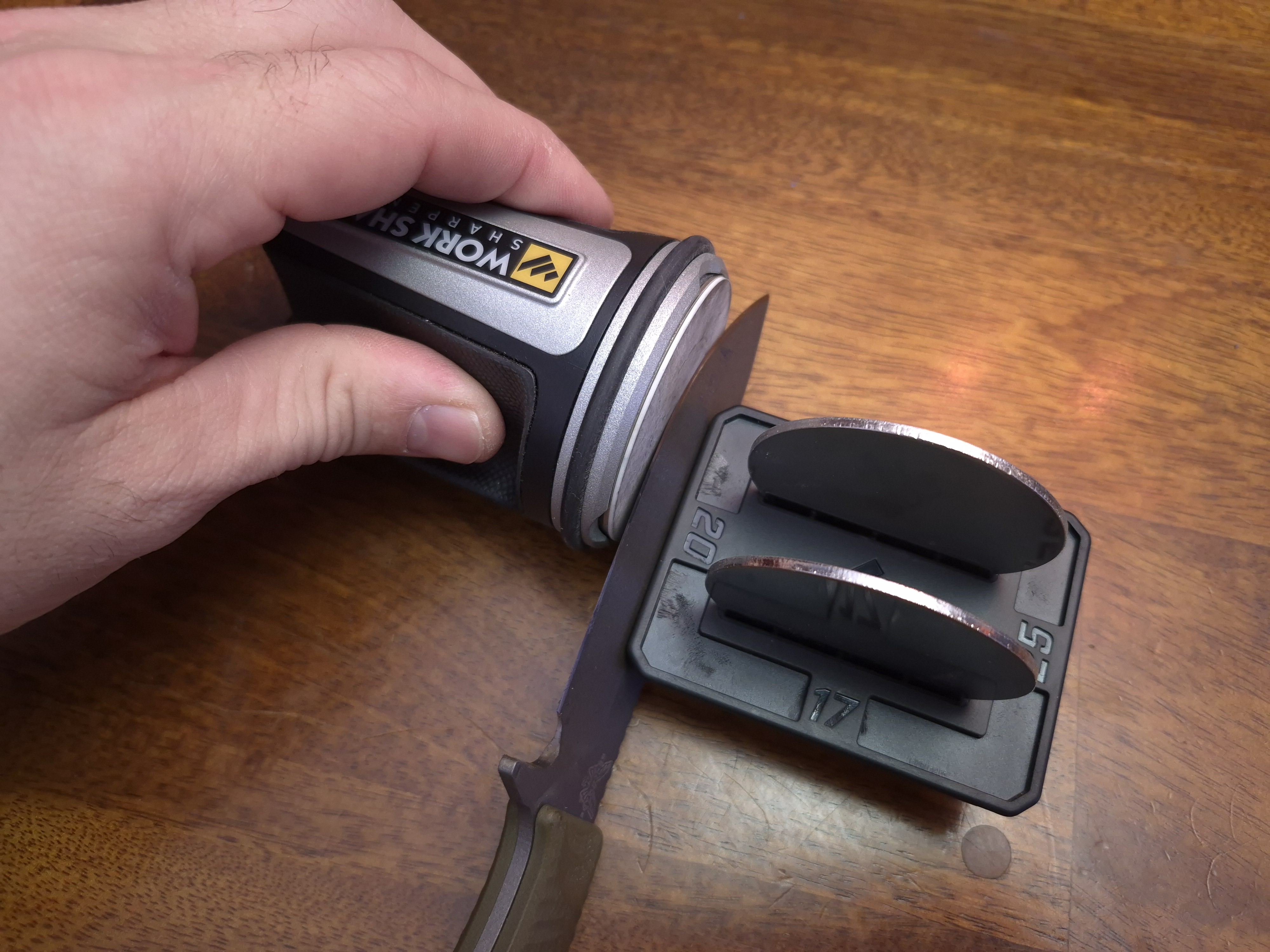
The Work Sharp Rolling Knife Sharpener is different than the traditional rolling sharpener in that it only has an abrasive disc on one side. The other side has two small wheels to keep it upright. It has a comfortable grip, and the abrasive discs are firmly held in by magnets but are easily swapped out. They also have a large diameter to handle knives with broader blades. The Worksharp is very versatile, and offers the most edge angles, but the HONE will take smaller blades than the Work Sharp.
At the end of the day, I got sharper edges with the Work Sharp base kit than any other base kit, and that is what it’s really all about. The 320-grit disc makes it fairly easy to re-profile a damaged edge, even on super steels like Cru-Wear and S35VN. The 600-grit diamond disc refines the edge quickly, and then the fine ceramic disc does a nice job really honing the edge. The first knife I sharpened had a shaving sharp edge when I finished. Touch up and edge maintenance is easy and quick, and the ceramic disc will bring a decent edge back to life quickly. Work Sharp has good directions and well made video tutorials for anyone new to sharpening that help to inspire confidence. Overall, the Work Sharp is comfortable, easy to use, versatile, and produced the best edges in the group. And it did it with a price tag that was middle of the pack. It’s one of the best knife sharpeners, especially in terms of ease of use.
Most Versatile: HONE
Pros
- Very strong block magnets
- Dual-sided discs extend life
- Comfortable and easy to roll
- Sharpens everything from large kitchen knives to a small Swiss Army Knife
Cons
- Solid axle makes it more difficult to turn to follow the belly of a blade
- Discs require a tool to change (tool included)
Key Features
-
Disc Grits:
400, 1000 -
Edge Angles:
15 and 20 degrees -
Warranty:
10 Year -
Price:
$105
Test Results
-
Sharpening:
Good -
Versatility:
Excellent -
Ease of Use:
Good
The HONE Knife Sharpener is simple and basic in its roller and disc design but has the best holding block design of the bunch. The first thing I noticed was how strong the magnets were. The firm hold inspired confidence, and I didn’t have to worry about the knife shifting if I applied extra pressure. The block also has the standard face angles, but the short sides of the block have shelves built in to hold much narrower blades. Between the strong magnets and grippy surface of the block, I could sharpen blades that were too narrow for the shelf. They would just be held in place, suspended above the shelf. The corners of the block are also chamfered to stay out of the way for the belly of short blades. The Block looks simple, but it was very well thought out.
The block is limited to either 15 or 20 degrees, but those are two very common and useful angles. As for the actual sharpener, it has a solid axle connecting the two wheels, so it doesn’t turn well, but it rides on ball bearings and does roll very smoothly. The discs are diamond coated on both sides to extend service life, but you will need the included tool to pry them off. The magnets are strong, and the notch is too small to get your finger into. The 400-grit disc is fine unless you have some chips that you want to fully remove, which will take considerable time as it is not very aggressive. Once you get a burr on both sides of the blade, you can move to the 1000 grit and get a great working edge on the blade. As with all of these sharpeners, a little patience in the finishing will yield the best results. If you want to be able to sharpen all your knives with a rolling sharpener, the HONE will give you the best chance to get your smallest blades sharpened up.
Best Budget: Mileiluoyue
Pros
- Only $25
- Two Extra sets of diamond discs
- Easy to roll
- Covers for discs included
Cons
- Inexpensive diamond coatings don’t last nearly as long as others, and don’t stand up to premium steels
- Impossible to pronounce
Key Features
-
Disc Grits:
400 and 1000 -
Edge Angles:
15 and 20 degrees -
Warranty:
“Simple Return and Exchange Policy” -
Price:
$25
Test Results
-
Sharpening:
Fair -
Versatility:
Poor -
Ease of Use:
Good
The Mileiluoyue rolling Knife sharpener did a very respectable sharpening job, regardless of the price. Was it as good as most others? No. Do the diamond discs last as long? Again, No. But, for $25, you can raise a burr with the 400 grit, and get it pretty well refined with the 1000 grit. If you are looking to use this sharpener to sharpen some inexpensive kitchen knives that are just labeled “stainless,” then this sharpener will work for you. The edges will be plenty sharp for home use, and the discs will take care of softer steel with not much problem. However, if you have some higher end cutlery, outdoor or kitchen, then the diamond coatings will not hold up for you very long at all. I tried this on some Cru-Wear on a high-end hunting knife, and it all but wiped out the 400 grit diamond disc. Obviously, to keep costs down, the bonding process and materials for the diamonds will be different and lower quality. I have diamond stones that have held up for over 500 blades, and these stones were pretty beaten up after one blade made from a super steel. However, they held up well enough with less expensive blades and softer steels that occupy the majority of the kitchens, and so this is a viable option if you don’t have pro level blades. The good news is that they supply you with 3 sets of discs which will help prolong the lifespan. At the end of the day, the Mileiluoyue Rolling sharpener produces a pretty good edge at a rock-bottom price.
Read Next: Best EDC Fixed Bladed Knives
Most Premium: HORL 2 Pro
Pros
- Easy to swap out discs if you purchase a kit or for a replacement
- Fastest sharpener
- Fine ceramic stone produces excellent edges
- Strong magnets
Cons
- Gear reduction means added rolling resistance
- Speed and premium engineering comes with a very premium price tag
Key Features
-
Disc Grits:
“Fine” Diamond and “Extra Fine” Ceramic (Base Kit) 3000, 6000 and Strop (Premium Set) -
Edge Angles:
15 and 20 degrees -
Warranty:
1 year -
Price:
$339
Test Results
-
Sharpening:
Excellent -
Versatility:
Good -
Ease of Use:
Good
The HORL 2 Pro was the fastest sharpener in the test, but there is a catch. The base kit comes with a diamond stone that feels like a 600 grit stone, (the actual grit rating is not listed), which means that it is less aggressive in removing material. That isn’t a problem if your edge needs a tune up, but if you have some chipping or rolling, a more aggressive stone or an electric knife sharpener would be better. However, the three rotations of the disc per every one rotation of the roller more than makes up for the finer grit.
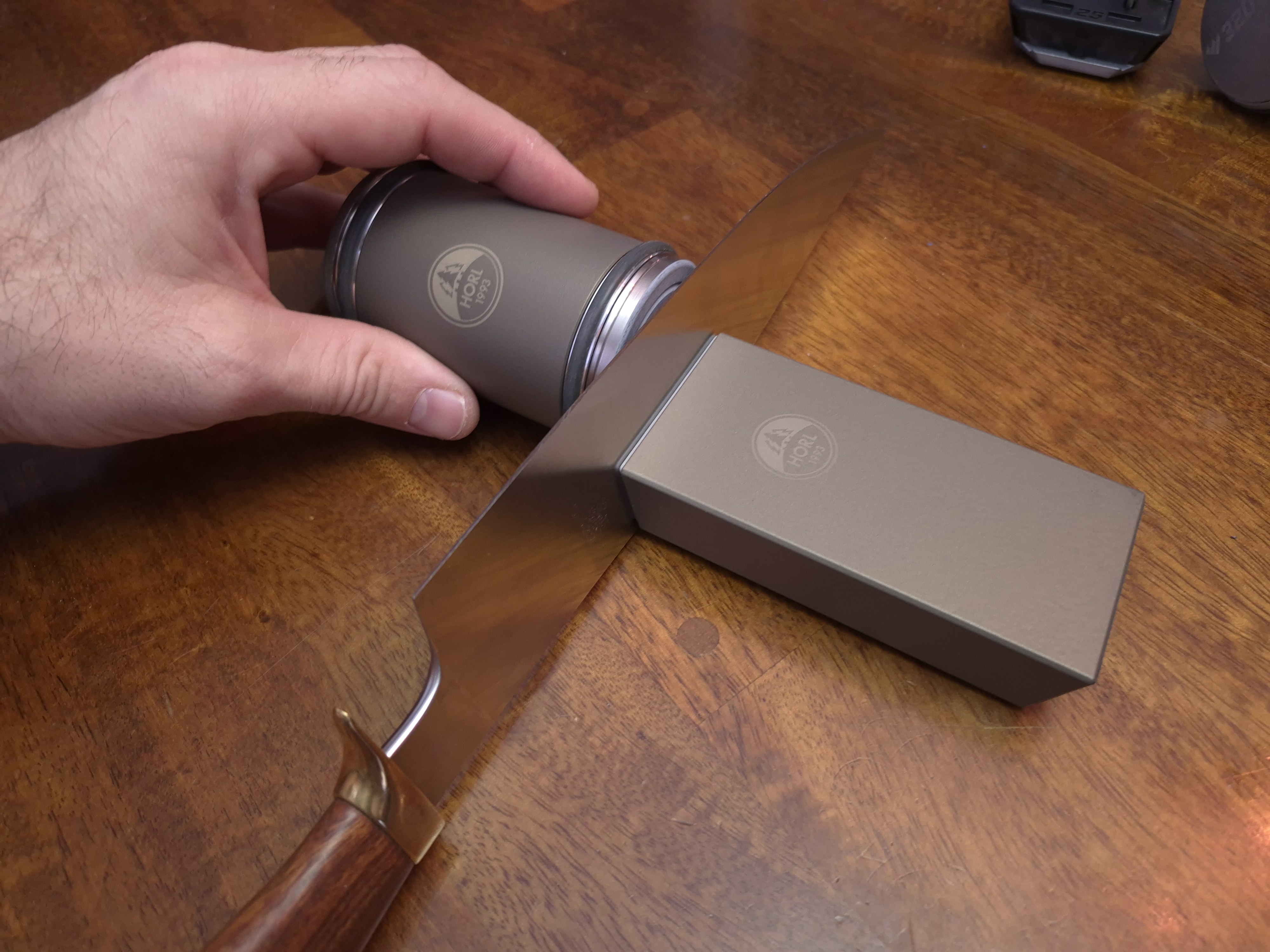
While the gear system speeds things up, the drawback is that it requires more effort to roll. It’s the same principle as a mountain bike, as you shift into a higher gear it requires more effort because the wheels are going faster. The other drawback is the price. If you want a coarse stone for re-profiling and edge repair, you’ll lay out another $85, and the Premium Set with 2 Whetstone discs and a strop is $139, all on top of the $339 for the base kit. If you do spring for the premium set and strop, this system gives the best edge of all the sharpeners, and for chefs with premium blades who want premium results, the HORL 2 Pro delivers. The base kit got me nearly identical results as the Work Sharp, but the optional Premium Set can produce a near-mirror polished edge. The HORL 2 Pro can sharpen some outdoor and EDC knives, but it is marketed and designed for high-end kitchen cutlery, and that is where it shines.
Tumbler Original
Pros
- Longest guarantee of all tested
- Steel hone outlasts diamond stones
- Very smooth rolling
- Compact block for easy storing
Cons
- Discs not replaceable
- Would like to have stronger magnets on the block
Key Features
-
Disc Grits:
D35 and steel hone -
Edge Angles:
15 and 20 degrees -
Warranty:
Lifetime -
Price:
$116
Test Results
-
Sharpening:
Good -
Versatility:
Fair -
Ease of Use:
Good
The Tumbler produced very solid, useable edges, and if you spring for the optional strop, your results will significantly improve. It is well constructed, and the diamond disc is far superior to the more budget options, and held up well with super steels. The Steel hone will require a bit more time than a fine diamond disc, and isn’t quite as effective at refining as a ceramic disc, but I was able to get acceptable results for home kitchen work.
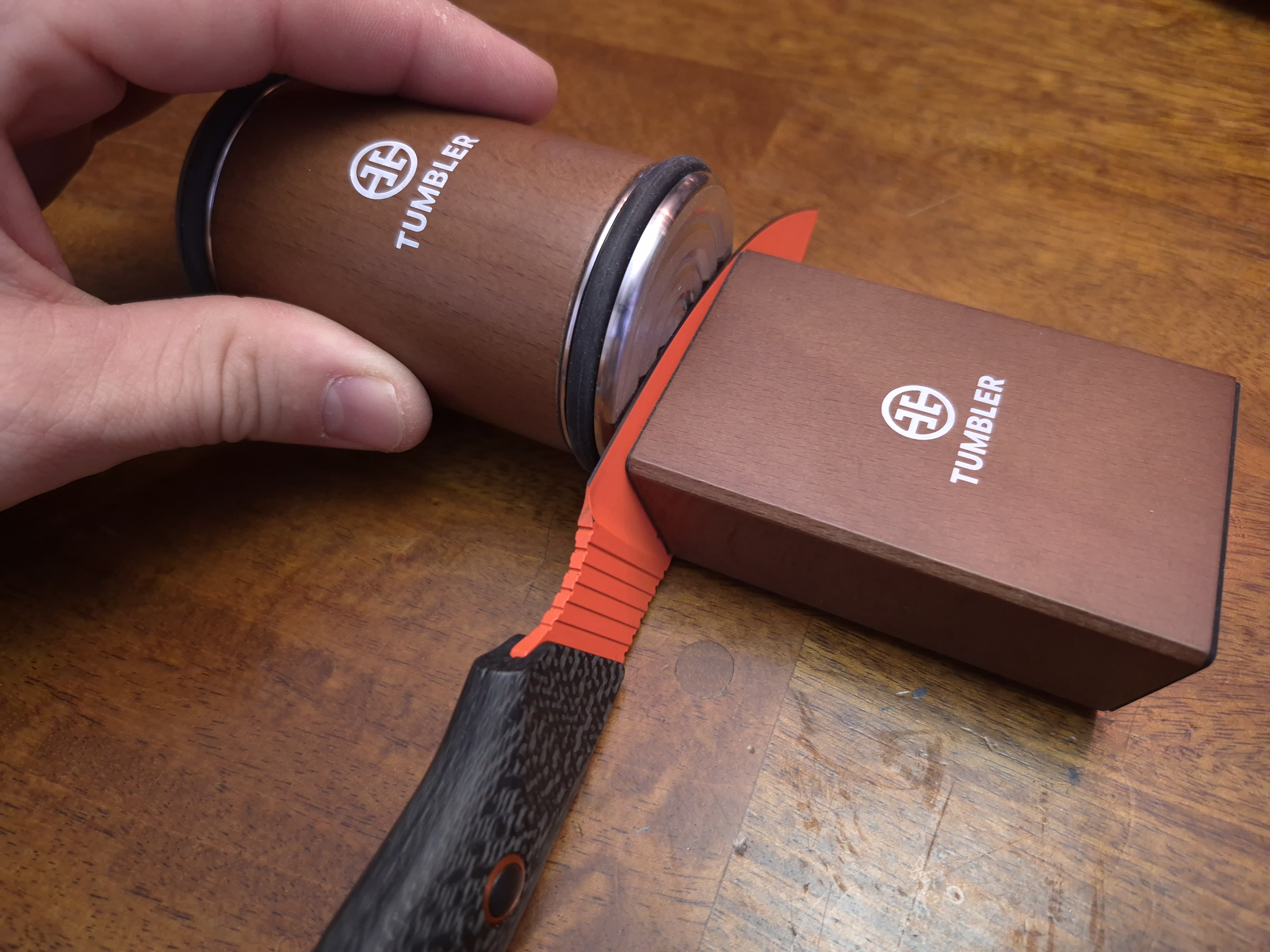
The magnets aren’t quite enough to hold small outdoor and pocket knives, so this lost some points for versatility, but for kitchen knives and broader EDC and outdoor knives, I was able to get good results as long as the knife didn’t have a small flat (unground portion of the blade up near the spine). Knives with a small flat tended to rock in and out, which changed the angle constantly. However, kitchen knives and flat-ground knives were easy to sharpen. The quality diamond coatings and long-lasting steel hone combined with the best warranty in the test definitely make the Tumbler an attractive option for those seeking a mostly kitchen-oriented sharpener.
HORL 3 Cruise
Pros
- High quality diamond abrasive
- Very grippy block pads
- Under $100
- Very Strong magnets
Cons
- Unable to change out discs
Key Features
-
Disc Grits:
Medium Block diamond and steel hone -
Edge Angles:
15 and 20 degrees -
Warranty:
1 Year -
Price:
$99
Test Results
-
Sharpening:
Good -
Versatility:
Excellent -
Ease of Use:
Good
The HORL 3 Cruise has the most grippy pads in the group and also has some of the strongest magnets. These qualities work together to make a block that will hold any size knife, even if it’s not indexed off the table its on. This makes the Cruise very versatile and suitable for small EDC knives as well as full size chefs’ knives. It rolls smoothy, and the newly designed diamond disc does a great job of removing material to profile, even though it doesn’t feel rough. It allows for a higher grit to have the grinding speed of a lower grit but maintains the finer scratches for a better edge.
The recycled plastic body and block make it lighter than the others I tested, and the sandy color would fit in a kitchen even if you left it out on a counter top. The HORL 3 Cruise really only has one drawback, and that is that when the diamond disc wears out, you’re buying a whole new sharpener. However, the diamond disc held up well to premium steels, which means that this should last the average user for quite some time. The stainless steel hone doesn’t quite finish an edge as well as some of the others, but if you have a strop, you can finish the edge very nicely. Overall, the Horl 3 Cruise was a solid performer, and it comes with the added bonus of helping to keep plastics out of the ocean.
Pietuley
Pros
- Kids under 10 think it’s cool looking
- Comes with extra set of discs
- Block is extra grippy to hold blades steady
- Good magnets
Cons
- Weird to grip and hold while rolling
- Lower quality diamond coatings wear out faster than others
- Front end of the “car” just scrapes along the table you’re sharpening on
Key Features
-
Disc Grits:
D35 and steel hone -
Edge Angles:
15 and 20 degrees -
Warranty:
Lifetime -
Price:
$116
Test Results
-
Sharpening:
Good -
Versatility:
Fair -
Ease of Use:
Poor
Can this futuristic sharpener actually sharpen knives? Yes. I was able to get a decent edge with it. But, it’s not comfortable to grip this sharpener, and some of the ways to hold that make it feel more comfortable put you at a higher risk of cutting yourself. The 400-grit disc is meant to rotate as you roll the sharpener, but the 1000-grit stays stationary. That feature isn’t a practical advantage, and it seems like its purpose is to differentiate it from other sharpeners.
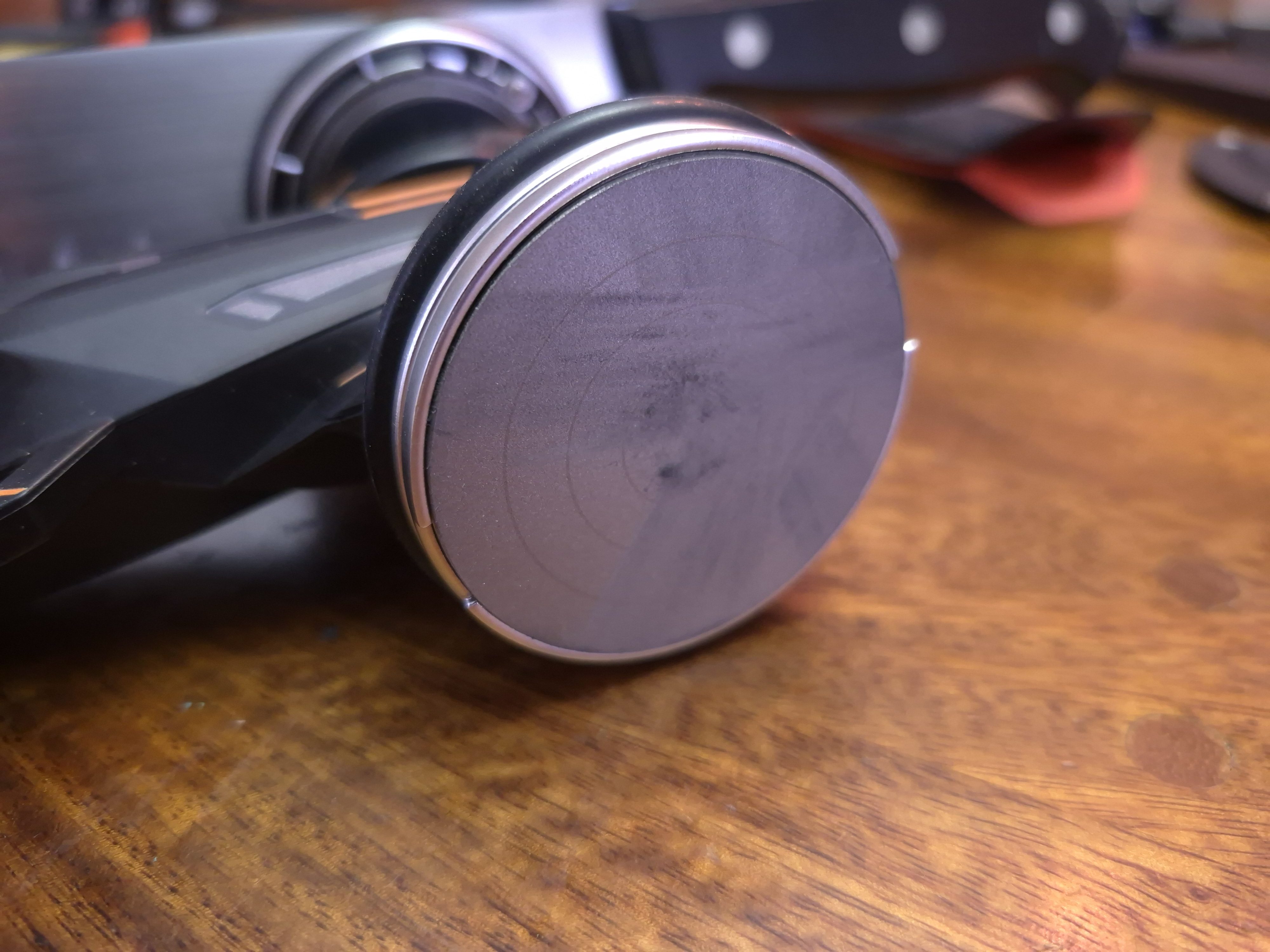
While all the other sharpeners have the edge facing up, the Pietuley has the edge facing down, which they claim lessens the risk of getting cut. The good news is that the magnets are strong, and the surface is very grippy, so the knives stay in place well enough even though they aren’t resting on the work surface. This also allows small knives to be easily held, but you will just have to be careful to place the blade the same way when you switch sides since there is no indexing off the work surface. Bottom line: The Pietuley will sharpen your knives, but because of the ergonomics, I wouldn’t choose it unless it was a gag gift, or you just love how it looks.
How I Tested the Best Rolling Knife Sharpeners

The testing for the sharpeners was straightforward: I sharpened a bunch of knives with them. I also dulled several of the knives repeatedly so I could test them on different sharpeners. It made me cringe to drag a good edge over a stone to dull it, but more data is better, and I wanted an apples-to-apples comparison.
I tried everything from cheap kitchen knives to EDC folding knives, to fixed blade camping knives, to a high-end chef’s knife that are made from cheap steels and super steels.
I evaluated how well the magnets and bases held the blades, how long it took to raise a burr, and how fine an edge the sharpener could achieve. Comfort and ease of use were also considered during testing, and there were some real differences in these areas. I also tested the versatility of each sharpener to find its limits with edge angle and blade size limitations. Each sharpener was tested as it came without added accessories.
I graded each sharpener on three key categories: sharpening, versatility, and ease of use.
- Sharpening: How refined of an edge could each sharpener produce?
- Versatility: Can the knife sharpen a wide range of knives?
- Ease of Use: Can anyone comfortably use the sharpener?
I gave each sharpener one of the following graded in each category:
- Poor: The product does not accomplish its mission.
- Fair: The product performs, but not well.
- Good: The product does an acceptable job.
- Excellent: The product is exceptionally good.
FAQs
A: It depends on the condition of the blade when you begin, but for a blade that isn’t really damaged and is just a bit dull, most of these will sharpen it up in under 5 minutes, and for knives that are decent but just need a hone you should be about a minute. Blades that have chips or rolls that you want to remove will change the time significantly. The lower the grit, that faster it will remove material, so a sharpener with lower grits will tend to be faster to reprofile and remove damage. Also, a smaller angle usually means a wider edge bevel which will usually equate to longer sharpening times as well as the first sharpening. The edge has to be profiled to the sharpeners angle the first time you sharpen it which can take some time, but after you’ve established that, subsequent sharpening on that blade will take much less time.
A: You need to raise a burr along the entire edge before switching to the other side of the blade. You should be able to feel the burr on the opposite side of the apex. After you have raised a burr along the entire edge on one side, flip the knife and repeat on the other side. After you have raised a burr on both sides, switch to your fine grit and repeat the process. After that, you can make 2-3 passes per side and alternate sides 3-4 times and that should totally remove your burr. Optional: Finish with a strop for best results.
A: You don’t NEED a strop. Taking time to make alternating passes at the end will yield pretty good results. However, having a strop with some compound on it will definitely take your edges beyond what stones and hones alone can do. I always recommend having a strop because using it for just a few passes after each use will keep your blades sharp for a long time between sharpening. If you don’t have a strop at home, some of these sharpeners, like Tumbler and HORL offer packages that come with a one, or you can purchase a strop separately.
Final Thoughts on the Best Rolling Knife Sharpeners
Rolling Knife Sharpeners have been aimed at kitchen cutlery from their inception, and that is still where they do their best work. Larger, broader blades tend to work best with this style sharpener, but some newer block designs like that on the Worksharp and HONE open rolling sharpeners up to nearly any style blade you want to sharpen. Overall, rolling sharpeners are easy to use and comparatively inexpensive with other fixed angle sharpening systems. Paired with a strop, rolling sharpeners can produce some very clean, sharp edges, and the higher-end ones will stand up to premium steels used in pro-level kitchen cutlery and outdoor and hunting blades. They are compact and portable and only need a flat surface to work. With some patience and practice, most of these sharpeners can get the advertised level of sharpness, and should take care of your kitchen cutlery with relative ease.
The post The Best Rolling Knife Sharpeners of 2025, Tested and Reviewed appeared first on Outdoor Life.
Source: https://www.outdoorlife.com/gear/best-rolling-knife-sharpeners/


